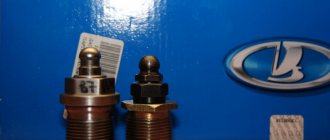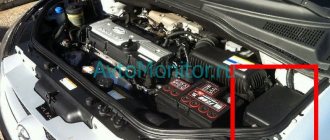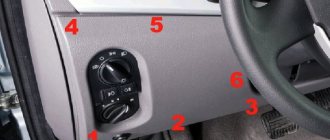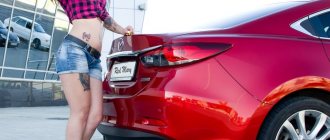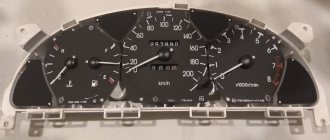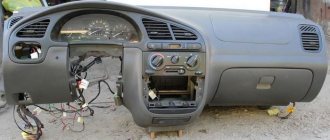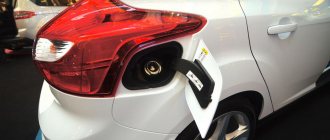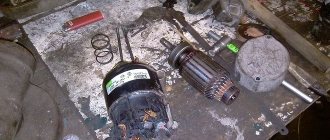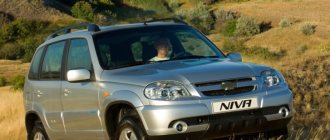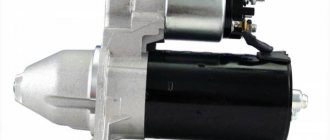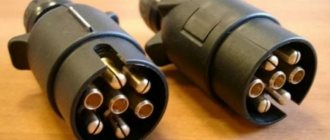This post is quick for me, so as not to constantly search for which fuse is responsible for what
K1 Sound signal K2 Headlight lamps Short circuit Electromagnetic clutch of the air conditioning compressor K4 Electric motor of an additional cooling system fan K5 Fog lamps K6 Side light lamps in the headlights, brake signal/side light lamps in the rear lights (side lights), instrument cluster backlight lamps , interior lamp lamp K7 Electric window motors for Chevrolet Lanos K8 Electric motor of the main cooling system fan K9 Electric motor of the fuel pump K10 Rear window heating element K11 Relay of the electric motors of the main and additional cooling system fans
F1 (10) Trunk courtesy lamp lamp, interior courtesy lamp lamp, fog lamp in the left rear lamp, antenna drive motor F2 (10) Light switch in the left steering column switch, fog lamp switch in the left rear lamp, headlight beam direction control , door open signal F3 (15) Hazard alarm F4 (15) Central locking F5 (10) Engine control unit power supply circuit from battery F6 (10) Audio system power supply circuit from battery F7 (15) Brake signal/side light lamps in rear lights (brake signals) D8 (diode) Door open warning switch (driver's door) F9 (10) Audio system power supply circuit from the ignition switch F10 (15) Chevy Lanos cigarette lighter fuse F11 (10) Instruments and indicators in the instrument cluster (except for fog lights, direction indicators and door open) clock, glove compartment light lamp F12 (10) Reversing light lamp in the right rear light F13 (15) Airbag F14 (15) Generator excitation, injectors, vehicle speed sensor, canister purge valve, exhaust recirculation valve gases, phase sensor F15 (15) Chevy Lanos ignition coil F16 (15) Turn indicator lamps in the headlights, direction indicator lamps in the rear lights, electric drive of the right outside rear view mirror F17 (15) Power circuits of the engine control unit and fuel pump relay from the ignition switch F18 (20) Windshield wiper motor, windshield washer pump motor F19 (10) Rear window defroster relay windings, air conditioning compressor relay, power window relay, relays (K4, K8, K11) cooling system fan motors F20 (20) Heater fan motor (1st, 2nd and 3rd speeds)
F1
– Main fuse = 80A
F2
system
1 = 30A
F3
– Ignition system 2 = 30A
Blower motor A = 30A
F5
Power windows* = 30A F6 – ABC* = 40A
F7
– Rear window defroster = 30A
F8
– Blower motor air (fourth speed level) = 30A
F10
- High beam headlights = 20A
F11
- Low beam (left headlight) = 10A
F12
- Low beam (right headlight) = 10A
F13
- Rear marker light (left) = 10A
F14
- Rear marker light lamp (right) = 10A
F15
– Front fog lamps = 15A
F16
– Fuel pump motor = 15A
F17
– Horn = 10A
F18
– Air conditioning compressor* = 10A
F19
– High beam = 25A
F20
– Interior lighting = 20A
Electrical relays
A
— Fuel pump relay
B
— Fog light relay
C
— Horn relay
D
— Interior light relay
E
Headlight relay
F
— Rear window defogger relay
G
— Power window relay*
H
— Air conditioning compressor relay*
I
— Fan motor control relay
J
— Fan motor relay A
K
- Fan motor relay B
L
- Fuse puller
D9
- Diode
Vehicle electrical circuits protected by fuses
(unit in the car)
F1
— Trunk light, interior light, electric antenna*, front fog lights* = 10A
F2
— Clock*, melodious beep, interior door light switches = 10A
F3
— Hazard warning lights = 15A
F4
— Electric central locking* = 15A
F5
- Engine ECU, Transmission ECU*, ABS ECU* - Battery power circuit = 10A
F6
- Audio system (battery power circuit) = 10A
F7
- Brake lights = 15A
F8
- Diode
F9
- Audio system* ( ignition switch circuit) = 10A
F10
— Cigarette lighter = 15A
F11
— Instrument panel, clock*, daytime running light module*, rear window defroster, glove box light*, melodic horn = 10A
F12
— Reversing lights = 10A
F13
— Inflatable airbag* = 15A
F14
— Injectors, alternator, engine sensor = 15A
F15
— Ignition system = 15A
F16
— Turn signal lights, electric exterior mirror* = 15A
F17
— Engine ECU, transmission ECU* (ignition switch circuits), module ABS warning light control*, fuel pump relay, VGIS* = 15A
F18
— Front and rear windshield wipers and washers = 20A
F19
— Rear window defroster relay, air conditioning compressor relay*, ECU, ABS* (ignition switch circuit), fan motor relay, Power window relay* = 10A
F20
- Blower motor (first, second and third speed stages)* = 20A
Note
ECU - electronic engine control unit. ABS - anti-lock braking system. VGIS - Induction manifold system. * — depends on the vehicle configuration. ——————————————————————————————————————
Chevrolet Lanos relay and fuses in the mounting block (under the hood)
Numbers of relays, fuses and fuse links in the mounting block:
1 — main fuse (80 A);
2 — ignition system 1 (30 A);
3 — ignition system 2 (30 A);
4 — main cooling system fan (30 A);
5 — electric windows (30 A);
6 — ABS relay (on vehicles equipped with ABS) (40 A);
7 — electric heating of rear window glass (30 A);
8 — electric heater fan (30 A);
9 — tweezers for removing fuses/electromagnetic clutch of the compressor drive (-/30 A);
10 — front fog lights/high beam headlights (15/20 A);
11 — fuel pump/low beam (left headlight), left headlight electric corrector (15/10 A);
12 — sound signal/low beam (right headlight), electric corrector of the right headlight (10 A);
13 — air conditioning compressor/side lights (left side), headlight leveling switch (10 A);
14 — contact “30” of relay 23 (high beam)/side lights (right side), license plate light (25/10 A);
15 — contact “30” of relay 26 (interior lighting)/fog lights (20/15 A);
16 — diode/electric motor of the fuel pump (-/15 A);
17 — high beam headlights/sound signals (20/10 A);
18 — low beam, left headlight/electromagnetic clutch of the air conditioning compressor drive (10 A);
19 — low beam, right headlight/headlight relay, headlight switch (10/25 A);
20 — side lighting, left side/relay for electric headlight corrector (10/20 A);
21 — side lighting, starboard side/relay No. 1 of the electric fan of the engine cooling system (10/15 A);
22 — horn relay/air conditioning compressor relay (20/15 A);
23 — headlight relay/headlight relay (20/16 A);
24 — air conditioning compressor relay/horn relay (20/16 A);
25 — relay of the additional electric fan of the cooling system/relay No. 2 of the electric fan of the engine cooling system (20/30 A);
26 — fog lamp relay/electric window relay (20 A);
27 — interior lighting relay/side light relay in the rear lights (20/16 A);
28 — power window relay/fog lamp relay (30/20 A);
29 — relay No. 2 of the electric fan of the engine cooling system (30 A);
30 — fuel pump relay, rear window heating relay (30 A);
31 — heated rear window glass relay/fuel pump relay (30 A);
32 — control relay for electric fans of the engine cooling system/jumper block (30/- A).
We carry out work when fuses and relays fail.
When removing fuses and relays, be sure to disconnect the wire terminal from the negative terminal of the battery.
On the cover of the mounting block in the engine compartment there is a diagram of the location of fuses and relays and their purpose is indicated.
To access fuses and relays located in the engine compartment mounting block...
...remove the steam exhaust hose from the holder on the cover of the mounting block.
After releasing the two spring latches, remove the cover of the mounting block.
Use tweezers to remove the fuse.
A faulty fuse is identified by a blown jumper.
Replace the blown fuse with a new one.
We remove the small relay from the block using tweezers.
We remove the large relay from the block by hand.
To access the fuses of the mounting block inside the car...
...press the lid latch...
...and remove the cover of the left side trim.
On the back of the cover there is a diagram of the location of the fuses and their purpose.
Using tweezers from the mounting block in the engine compartment, you can replace the blown fuse with a new one.
A new relay or fuse should be installed in place of a failed one only after the cause of the malfunction has been determined and eliminated.
It is allowed to use only standard fuses designed for a certain rated current (the rated current of the fuse is indicated on its body).
The Chevrolet Lanos has earned an excellent reputation and is in demand among domestic drivers. Almost everyone notes its reliability, unpretentiousness, efficiency and ease of maintenance.
Chevrolet Lanos car
The design is really simple and thought out to the smallest detail. The developers also paid attention to the electrical equipment protection system, placing fuses in two blocks, as well as in one additional block with a relay.
But a situation where some electrical consumer fails can happen even on such a reliable vehicle. For example, very often the cigarette lighter, lighting or heating fails. Some drivers immediately get lost and go to a service station, spending a lot of money for something they could do on their own in just a few minutes.
Chevrolet Lanos cars are purchased mainly by people with average incomes, so performing many jobs is very important for many.
Removal and replacement instructions
Replacing fuses and relays on a Chevrolet Lanos, both under the hood and in the interior unit, is almost identical.
Preparation
Before proceeding to replacing the fuse, we recommend de-energizing the system. To do this, turn off the ignition and, to be on the safe side, take out the key. It would also be a good idea to disconnect the negative terminal of the battery.
- If some consumer fails, the first thing we do is determine which block it is located in. This is done very simply. We look at its number in the decoding, then find its location on the diagram.
- If the electrical fuse is located in the engine compartment, then we need to remove the steam exhaust hose and open the cover. If the element we need is located in the interior compartment, then it is enough to open the lid itself. These are all the differences between replacing a fuse in the engine compartment or the passenger compartment.
- Next, using tweezers, remove the problematic fuse. We examine it, trying to visually determine whether it is intact or burnt out. It is better, of course, to do this work using a tester. Although it should be visually noticeable that the conductive part is burnt out, and in some cases the plastic shell itself may be melted.
- Now we need to remove a fuse of similar rating from the spare set and install it in place of the blown one.
- Replace the “-” terminal of the battery. We start the car.
- We check the work of the consumer.
If the problem was in the fuse, then the equipment should work. If the fuse blows again, then the problem is much more serious. It is necessary to inspect the wiring and the consumer itself.
Scheme and progress of replacing relays and protective elements in the engine compartment
Explanation of the circuit of electrical fuses and relays located in the engine compartment
Scheme and progress of replacing protective elements in the engine compartment
Deciphering the circuit with protective elements in the interior compartment
Replacement
We started the article with unexpected malfunctions of electrical appliances. Once you have an idea of what the Chevrolet Lanos fuse box looks like and what its elements are responsible for, you can begin troubleshooting. The most common failure is the cigarette lighter, so let's look at the replacement process using it as an example.
First of all, you need to make sure that the cigarette lighter is really not working. There may be several reasons why it stopped performing its direct duties or charging your gadgets:
- blown fuse;
- clogged contact;
- inconsistent charger contact due to its configuration;
- problems with wiring or contacts.
The last case is very rare and least likely. We make sure that the nest is not filled with debris, dust, ash or tobacco. If so, clean the nest. Then check if your gadget's charger fits well into the socket. Perhaps this will be the problem and will be solved by purchasing a new charger. So, if all of the above problems do not affect you, then you need to replace the fuse. It is located in the indoor unit (read above for how to get to it) and is marked F10. Using tweezers, remove the old PP, make sure that it is really burnt (black, charred, melted) and insert a new one of the same rated current (15 A) in its place.
Also, Chevrolet Lanos car owners are faced with the fact that the car will not start. This problem can often be solved by replacing the fuel pump fuse. Watch the replacement video:
The Chevrolet Lanos has earned an excellent reputation and is in demand among domestic drivers. Almost everyone notes its reliability, unpretentiousness, efficiency and ease of maintenance.
Chevrolet Lanos car
The design is really simple and thought out to the smallest detail. The developers also paid attention to the electrical equipment protection system, placing fuses in two blocks, as well as in one additional block with a relay.
But a situation where some electrical consumer fails can happen even on such a reliable vehicle. For example, very often the cigarette lighter, lighting or heating fails. Some drivers immediately get lost and go to a service station, spending a lot of money for something they could do on their own in just a few minutes.
Chevrolet Lanos cars are purchased mainly by people with average incomes, so performing many jobs is very important for many.
Read more: Replacing the front crankshaft oil seal UAZ Bukhanka
Recommendations for use
- Every prudent driver must have a set of electrical fuses of various ratings, this is especially necessary for those drivers who drive long distances. They cost pennies, but at some point they can help out a lot.
- Sometimes, if some equipment fails, but the electrical fuse is intact, it is enough to move it a little in the connector. Perhaps carbon deposits or rust caused the chain to break.
- Replace only with an item of similar value. If you put in less, it may burn out immediately. If it is more, it will not be able to properly protect the equipment.
- Under no circumstances should you install wires or bugs, which in some situations can cause the car to catch fire.
Sorry, there are no surveys available at this time.
Block in the control panel
Finally, the third block is located in the instrument panel. It is responsible for fewer actions in the car system, but is also significant and important. Below is a table of the main functions that this unit provides to the vehicle.
| Number | Designation |
| 1 | Tail lamp relay |
| 2 | Fan relay |
| 3 | Windshield wiper relay |
| 4 | Relay for turning headlights and hazard lights |
Thus, you can see that each block is responsible for a specific area in the car system, allowing you to drive it comfortably and safely. All fuses and relays are aimed at improving the operation of the vehicle.
Video “How to find the required protective element”
This video shows which fuse is responsible for the fuel pump. The cigarette lighter fuse is changed in the same way.
Throw off the fuse designations on Lanos.
- Where are the fuses on Lanos? – 1 answer
The fuse blocks on Lanos are located in several places.
Fuse and relay box in the engine compartment.
- Circuits of fuses EF15–EF20 and interior fuses F1–F7;
- Ignition switch (IGN1);
- Ignition switch (IGN2);
- Cooling fan electric motor;
- Electric window lifter and sunroof drive motor (if there is a window lifter and sunroof);
- ABS relay (if equipped with ABS);
- Rear window defroster (hatchback only);
- Electric motor of the interior ventilation system;
- Electromagnetic clutch for air conditioning compressor drive (if equipped);
- High beam left and right headlights;
- Low beam (left headlight), electric motor for beam corrector of the left headlight;
- Low beam (right headlight), electric motor for right headlight beam corrector;
- Side lights (left side), switch for electric motors for light beam correctors;
- Side lights (right side), license plate light;
- Fog lights;
- Fuel pump electric motor;
- Sound signals;
- Electromagnetic clutch for air conditioning compressor drive (if equipped);
- Headlight relays, headlight switches, turn signals;
- Headlight beam adjustment relay and fuse circuit EF13;
- Not used;
- Air conditioning compressor relay;
- Headlight relay;
- Horn relay;
- Radiator fan relay;
- Power window relay;
- Dimensions relay;
- Not used;
- Not used;
- Rear window defroster relay;
- Fuel pump relay;
- Jumper block.
From 1 to 20 fuses are designated EF (except for point 9 - this is diode D9). From 21 to 32 - relay.
Rated current: red - 10 A, blue - 15 A, yellow - 20 A, white - 25 A.
Fuse box in the cabin.
- Interior lighting, trunk lighting;
- Headlight switch;
- Emergency;
- Not used;
- Controller;
- Audio system;
- Brake lights;
- Not used;
- Audio system;
- Cigarette lighter;
- Instrument cluster, clock, seat belt warning light, glove box light;
- Reversing light;
- Not used;
- Generator, speed sensor, injectors, adsorber, exhaust gas recirculation valve;
- Ignition module;
- Emergency;
- Controller, fuel pump relay;
- Electric motor for windshield wiper and washer pump;
- Cooling fan relay, rear window defroster relay;
- Electric motor of the interior ventilation system.
The fuses in the passenger compartment are located on the left, near the driver's feet. To get to them you will need to remove the protective cover.
Subscribe
to our channel in
Index.Zen
Even more useful tips in a convenient format
Often, car owners are faced with a faulty electrical appliance and do not know what to do next. It would seem that the electrical circuit of the car is too complex and not everyone can find the cause of the malfunction. Is it really necessary to take your Chevrolet Lanos to an electrician in case of any breakdown? Of course not. The most common reason that an electrical appliance stops working is blown fuses. Therefore, before you panic and go to the mechanic, you need to look into the fuse block (BP) of the Chevrolet Lanos and inspect it.
Modern cars traditionally have two fuse blocks: the main (or mounting) and the additional. Since this is not a completely correct gradation (neither one is more important than the other) many people call them the inner and outer blocks. The power supply unit is equipped with fuses (FC) of various rated currents and relays. Both those and other power supply elements serve to protect electrical circuit devices. PPs are instant action elements, that is, they burn out at the moment when the current in the circuit exceeds the rated value (which is individual for each PP). Relays protect circuit elements from severe overloads: from short circuits and the accompanying enormous voltage in the circuit.
Daewoo Lanos Chevrolet Lanos
Circuit breakers
Volkswagen Passat B3 fuse box decoding tables
If any device or instrument that is part of the electrical equipment of your car fails, you must first check the serviceability of the fuses of the failed electrical equipment, and then all other fuses. To do this, you need to find the fuse (or fuses) that protects the circuit of the failed device or appliance. If all fuses are in order, then the cause of the malfunction must be sought in the electrical equipment itself. It is necessary to replace blown fuses and check the functioning of failed vehicle devices.
Fuse and relay box in the engine compartment
NoteThe location of the fuses in the block is indicated on the fuse block cover.
| Fuse number/current rating (A) | Protected circuit |
| F1/80 | Various electrical equipment |
| F2/30 | Electrical equipment that operates when the key is turned to the ACC and ON positions and turns off when the key is turned to the START position |
| F3/30 | Electrical equipment that operates when the key is turned to the ACC, ON, START position |
| F4/30 | Engine cooling fan |
| F5/30 | Power windows (if equipped) |
| F6/40 | Not used |
| F7/30 | Heated rear window |
| F8/30 | Ventilation system fan |
| F9/15 | Front fog lights (if equipped) |
| F10/15 | Fuel pump |
| F11/10 | Sound signal |
| F12/10 | Not used |
| F13/25 | Headlights |
| F14/20 | Outdoor Lighting |
| F15/10 | Not used |
| F16/20 | High beam headlights |
| F17/10 | Low beam of the front left headlight |
| F18/10 | Low beam of the front right headlight |
| F19/10 | Electric headlight adjustment, brake light, exterior lighting on the left side |
| F20/10 | Brake light, exterior lighting on right side |
| R1 | Sound signal |
| R2 | Headlights |
| R3 | Not used |
| R4 | Engine cooling fan (low speed) |
| R5 | Fog lights (if equipped) |
| R6 | Outdoor Lighting |
| R7 | Power windows (if equipped) |
| R8 | Engine Cooling Fan (High Speed) |
| R9 | Fuel pump |
| R10 | Heated rear window |
| R11 | Not used |
Note Relay and fuse blocks may differ depending on the vehicle configuration.
Fuse and relay box in the passenger compartment
NoteThe location of the fuses in the block is indicated on the fuse block cover.
| Fuse number/current rating (A) | Protected circuit |
| F1/10 | Interior and luggage compartment lighting, rear lights |
| F2/10 | Outdoor lighting, headlights, clocks |
| F3/15 | Alarm |
| F4/15 | central locking |
| F5/10 | Engine management system |
| F6/10 | Audio system |
| F7/15 | Brake lights |
| F8/- | Diode |
| F9/10 | Audio system |
| F10/15 | Cigarette lighter |
| F11/10 | Instrument cluster |
| F12/10 | Reversing light |
| F13/15 | Passive safety system |
| F14/15 | Generator, starter solenoid relay, engine management system |
| F15/15 | Ignition system |
| F16/15 | Direction indicators |
| F17/15 | Fuel pump relay, engine management system |
| F18/20 | Windshield wipers and washers |
| F19/10 | Cooling fan, rear window defroster, power windows (if equipped) |
| F20/20 | Ventilation system fan |
Fuse and relay box on the left of the instrument panel
The following relays are installed in this block: rear fog lamp relay, turn signal relay, front windshield wiper intermittent relay, ventilation system fan relay.
Main unit
The external power supply is located in the engine compartment of the Chevrolet Lanos. The block itself is protected on top by a lid, which can be removed by pressing a couple of latches on the sides. On the back of the cover you will find the electrical diagram of the unit and several spare fuses. Main block diagram:
In reality, the external block looks like this:
It contains 20 PP marked EF and 11 relays, which are marked with the letter K. Before changing any element of the block, you need to know in which device circuit it is connected. PP are responsible for the following elements:
Power supply relays are responsible for:
- horn;
- operation of low and high beam headlights;
- clutch operation in the air conditioning compressor;
- radiator fan (optional);
- operation of fog lights;
- operation of the side lights of the front and rear of the car, brake lights, dashboard lighting and interior lighting lamps;
- electric windows front and rear windows;
- radiator fan (main);
- fuel pump;
- heated rear window (if provided);
- radiator fan control unit.
Fuse and relay box under the hood
It is located near the battery and is closed with a protective cover, which is held on by two side latches.
Block diagram
Description of fuses and relays Chevrolet Lanos
Circuit breakers
| EF1 | 80A Fuse circuits EF15 - EF20 and F1 - F7 |
| EF2 | 30A Ignition switch (power supply circuit for instrument cluster and fuel pump) |
| EF3 | 30A Ignition switch (starter, heater fan, power windows) |
| EF4 | 30A Electric motors of the main and additional fans |
| EF5 | 30A Electric window motors |
| EF6 | 50A Not used |
| EF7 | 30A Rear window heating element |
| EF8 | 30A Heater fan motor (4th speed) |
| D9 (diode) | Air conditioning compressor electromagnetic clutch |
| EF10 | 20A Headlight bulbs (high beam) |
| EF11 | 10A Lamp for the left headlight (low beam), motor-reducer for adjusting the direction of the light beam of the left headlight |
| EF12 | 10A Lamp for the right headlight (low beam), motor-reducer for adjusting the direction of the light beam of the right headlight |
| EF13 | 10A Brake signal/side light lamp in the left rear light (side light), instrument cluster illumination, melodic signal, side light lamp in the left headlight, headlight beam adjustment switch, fog light switch in the rear light, clock, switch hazard warning lights, ashtray lights, audio system, chevrolet lanos air conditioning switch |
| EF14 | 10A Brake/side light lamp in the right rear light (side light), side light lamp in the right headlight, license plate lights |
| EF15 | 15A Chevrolet Lanos fog lamps |
| EF16 | 15AT fuel pump |
| EF17 | 10A Horn |
| EF18 | 10A Electromagnetic clutch of the air conditioning compressor |
| EF19 | 25A Contact “30” headlight relay |
| EF20 | 20A Contact “30” side light and interior lighting relay |
Relay
| Name | |
| K1 | Sound signal |
| K2 | Headlight bulbs |
| short circuit | Air conditioning compressor electromagnetic clutch |
| K4 | Additional cooling fan motor |
| K5 | Fog lamps |
| K6 | Side light lamps in the headlights, brake signal/side light lamps in the rear lights (side light), instrument cluster illumination lamps, interior courtesy lamp |
| K7 | Power window motors |
| K8 | Main cooling fan motor |
| K9 | Fuel pump motor |
| K10 | Rear window heating element |
| K11 | Relay for the electric motors of the main and additional cooling system fans |
This is interesting: Oil pressure sensor for Toyota Camry 40: where is it located, replacement
Additional block
The indoor unit is located next to the driver's left knee. It can be accessed by opening the lid with a latch. On the back of the cover there is a diagram of the block, and it is also written what each of the elements is responsible for. True, usually these inscriptions are made in the language of the country that assembled your car or in English.
It contains 19 fuses marked F and 1 diode (D), which are responsible for:
Also in the interior of the Chevrolet Lanos car there is a relay unit consisting of four elements. It is located behind the headlight dimmer cover.
where the elements are responsible for the following electrical appliances:
- turn signals and emergency lights;
- rear fog lamp;
- windshield wipers;
- interior heating fan.
Procedure for checking an electrical relay
You can find out the reason why the fuel pump stops working by checking its switching circuits, which includes a relay. It is an electrical device that, at the command of the electronic power supply, provides power to the pump motor, and when the contacts open, it stops this supply. Its malfunction is often associated with a breakdown of its coil or due to oxidation or burnt contacts that will need to be cleaned.
The Chevrolet Lanos fuel pump relay, where the control and controlled part (contact group) is located, as well as the fuses, is located in the mounting block of the engine compartment - in the right front corner.
To check the serviceability of the K9 relay, you will need instruments such as a multimeter or test light, a probe and a piece of wire. However, if the fuel pump is not working, first of all, it is recommended to check the serviceability of fuses F17 and F16, typical for Chevrolet Lanos. How to check the fuel pump relay is a frequently asked question, and the answer is quite simple - you just need to use one of the methods below.
- First, you will need to remove the device from the mounting block and replace it with a working type, for example, relay K7 (for power windows). Turning on the fuel pump with an alternative relay indicates a faulty relay. If it does not turn on, we check the power and control circuits of the electrical device.
- If there is no spare working relay, a similar method above to check the serviceability of the device is to install a jumper (a piece of wire, a paper clip) between contacts 30 and 87, which will close them when the ignition is on.
- You can determine whether the device needs to be replaced by measuring the voltage between pin 86 and ground (minus). When the ignition is on, it should be equal to 12 V. We also check the voltage between pin 30 and ground. It is equal to the on-board network voltage. Its absence indicates a break in the wires between the contacts and ground. Otherwise, you need to connect the probe between pin 85 of the relay harness block and the positive terminal of the battery. If the probe lamp does not light up when the ignition is turned on, this indicates a malfunction of the controller or a broken wire. If the lamp comes on, it indicates the need to replace the electrical device.
- Also, using a tester in ohmmeter mode between pin 85 and the vehicle ground, you can measure the resistance, which if the circuit is working properly should be 1 ohm.
Car enthusiasts who are interested in this model can find out how much the new Chevrolet Lanos costs on various Internet sites. The price of a new sedan varies from 250 thousand rubles. and higher depending on the configuration: basic S, medium SE and maximum SX.

